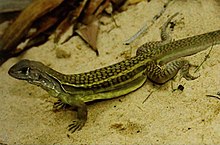| Leiolepis ngovantrii | |
|---|---|

| |
| Conservation status | |
 Vulnerable (IUCN 3.1) | |
| Scientific classification | |
| Domain: | Eukaryota |
| Kingdom: | Animalia |
| Phylum: | Chordata |
| Class: | Reptilia |
| Order: | Squamata |
| Suborder: | Iguania |
| Family: | Agamidae |
| Genus: | Leiolepis |
| Species: | L. ngovantrii |
| Binomial name | |
| Leiolepis ngovantrii Grismer & Grismer, 2010 | |
Leiolepis ngovantrii (Vietnamese: Nhông cát trinh sản, meaning "parthenogenic sand iguana") is a species of lizard that is all-female, reproducing clonally. The species is named after Vietnamese herpetologist Ngo Van Tri (born 1969) of the Vietnam Academy of Science and Technology, and is believed to be related to two other Vietnamese lizard species, Leiolepis guttata and Leiolepis guentherpetersi. This species is one of four unisexual Leiolepis agamospecies. However, the genus Leiolepis has five different bisexual species. This unisexuality is possibly due to mutation and hybridization.
Description
L. ngovantrii in the type series measure 95–127 mm (3.7–5.0 in) in snout–vent length. The lizard's back is covered with brown spots with pairs of yellow stripes running along her sides. Her coloring provides adequate camouflage in coastal sandy soil, as well as the mangrove forests during the dry season when grasses and leaves turn pale yellow.
Scientific discovery
Though the lizard has been long known to and enjoyed by locals in Vietnam's Mekong River Delta, scientists described the species in 2010 after seeing them sold and eaten in many remote Vietnamese village restaurants in Bà Rịa–Vũng Tàu province, South Vietnam.
References
- Grismer, L. & Nguyen, N.S. 2018. Leiolepis ngovantrii. The IUCN Red List of Threatened Species 2018: e.T99931318A99931327. https://www.iucnredlist.org/species/99931318/99931327. Downloaded on 20 December 2020.
- ^ Grismer, Jesse L.; Grismer, L. Lee (2010). "Who's your mommy? Identifying maternal ancestors of asexual species of Leiolepis Cuvier, 1829 and the description of a new endemic species of asexual Leiolepis Cuvier, 1829 from Southern Vietnam" (PDF). Zootaxa. 2433: 47–61. (Leiolepis ngovantrii, new species).
- ^ Leiolepis Grismer at the Reptarium.cz Reptile Database. Accessed 26 September 2017.
- Nosowitz, Dan (November 9, 2010). "Scientists discover self-cloning lizard species on Vietnamese restaurant menu". Popular Science. Retrieved November 9, 2010.
- Beolens, Bo; Watkins, Michael; Grayson, Michael (2011). The Eponym Dictionary of Reptiles. Baltimore: Johns Hopkins University Press. xiii + 296 pp. ISBN 978-1-4214-0135-5. (Leiolepis ngovantrii, pp. 189-190).
- ^ "Scientists discover unknown lizard species at lunch buffet" (CNN, November 10, 2010).
- Hartmann, Timo; Sothanin, Sovath; Handschuh, Markus; Bohme, Wolfgang (May 10, 2011). "THE TAXONOMIC STATUS OF THE RED-BANDED BUTTERFLYLIZARD, Leiolepis rubritaeniata MERTENS, 1961,WITH DISTRIBUTIONAL AND NATURAL HISTORY NOTES". Russian Journal of Herpetology. 19: 108.
- Grismer, L. Lee; Grismer, Jesse L. "Who's your mommy? Identifying maternal ancestors of asexual species of Leiolepis Cuvier, 1829 and the description of a new endemic species of asexual Leiolepis Cuvier, 1829 from Southern Vietnam" (PDF). Mapress.
- Bí ẩn loài nhông cát trinh sản Archived 2010-11-10 at the Wayback Machine. (in Vietnamese).
| Taxon identifiers | |
|---|---|
| Leiolepis ngovantrii | |
This lizard from family Agamidae article is a stub. You can help Misplaced Pages by expanding it. |